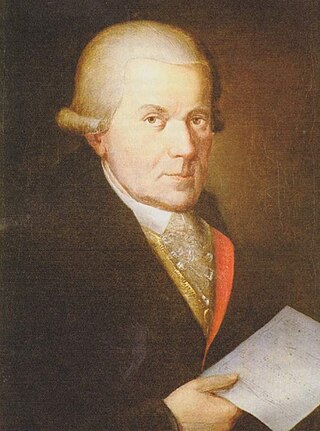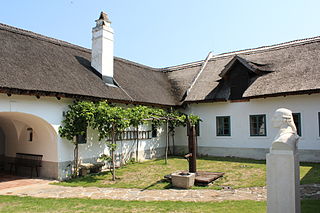
Franz Joseph Haydn was an Austrian composer of the Classical period. He was instrumental in the development of chamber music such as the string quartet and piano trio. His contributions to musical form have led him to be called "Father of the Symphony" and "Father of the String quartet".

Johann Michael Haydn was an Austrian composer of the Classical period, the younger brother of Joseph Haydn.

Eisenstadt is the capital city of the Austrian state of Burgenland. With a population of 15,074, it is the smallest state capital and the 38th-largest city in Austria overall. It lies at the foot of the Leitha Mountains hill range.

Anton Florian was the Prince of Liechtenstein between 1718 and 1721.

Bruck an der Leitha is a town in the state of Lower Austria of Austria on the border of Burgenland, marked by the Leitha river. In 2018 it had a population of around 8,000.

Hainburg an der Donau is a town located in the Bruck an der Leitha district in the state of Lower Austria of eastern Austria. In 2021 it had a population of about 7,000.

Johann Adam Joseph Karl Georg Reutter, during his life known as Georg Reutter the Younger was an Austrian composer. According to David Wyn Jones, in his prime he was "the single most influential musician in Vienna".

The House of Harrach is the name of an old and influential Austro-German noble family, which was also part of the Bohemian nobility. The Grafen (Counts) of Harrach were among the most prominent families in the Habsburg Empire. As one of a small number of mediatized houses, the family belongs to the High nobility.

Petronell-Carnuntum is a community of Bruck an der Leitha in Austria. It is known for its annual World Theatre Festival.

Potzneusiedl is the smallest village in the district of Neusiedl am See in Burgenland in Austria.
Mathias Haydn was the father of two famous composers, Joseph and Michael Haydn. He worked as a wheelwright in the Austrian village of Rohrau, where he also served as Marktrichter, an office akin to village mayor.

Mannersdorf am Leithagebirge is a town in Austria. It is located in the district of Bruck an der Leitha in the state of Lower Austria. Mannersdorf is seated at the base of a range of wooded hills called the Leitha Mountains (Leithagebirge), from which it receives its full name. It overlooks an agricultural plain, through which flows the Leitha River, about two miles away.

Count Karl Joseph of Morzin (1717–1783) was a Bohemian aristocrat from the Morzin family, remembered today as the first person to employ the composer Joseph Haydn as his Kapellmeister, or music director. The first few of Haydn's many symphonies were written for the Count.
Karl Geiringer was an Austrian-American musicologist, educator, and biographer of composers. He was educated in Vienna but at the beginning of the Nazi years he emigrated to England and ultimately the United States, where he had a lengthy and distinguished career at several universities. He was a noted authority on Brahms, Haydn, and the Bach family, and a prolific author.

The name of the composer Joseph Haydn had many forms, following customs of naming prevalent in his time.

Nicola Maria Rossi, also known as Nicolò Maria was an Italian painter of the late-Baroque.

Schloss Rohrau is a castle in the town of Rohrau in Lower Austria, bordering on Burgenland. The building houses the art collection of the counts of Harrach.

Haydn's birthplace is in Rohrau in Lower Austria. The composer Joseph Haydn was born here in 1732. Today it is a museum.

Ferdinand Bonaventura, Count of Harrach and Rohrau was an Austrian statesman, diplomat and courtier from the noble family of Harrach, Knight of the Order of the Golden Fleece and owner of estates in Austria and Bohemia. To distinguish him from his grandson of the same name, he is referred to in contemporary sources as Ferdinand Bonaventura I.






















